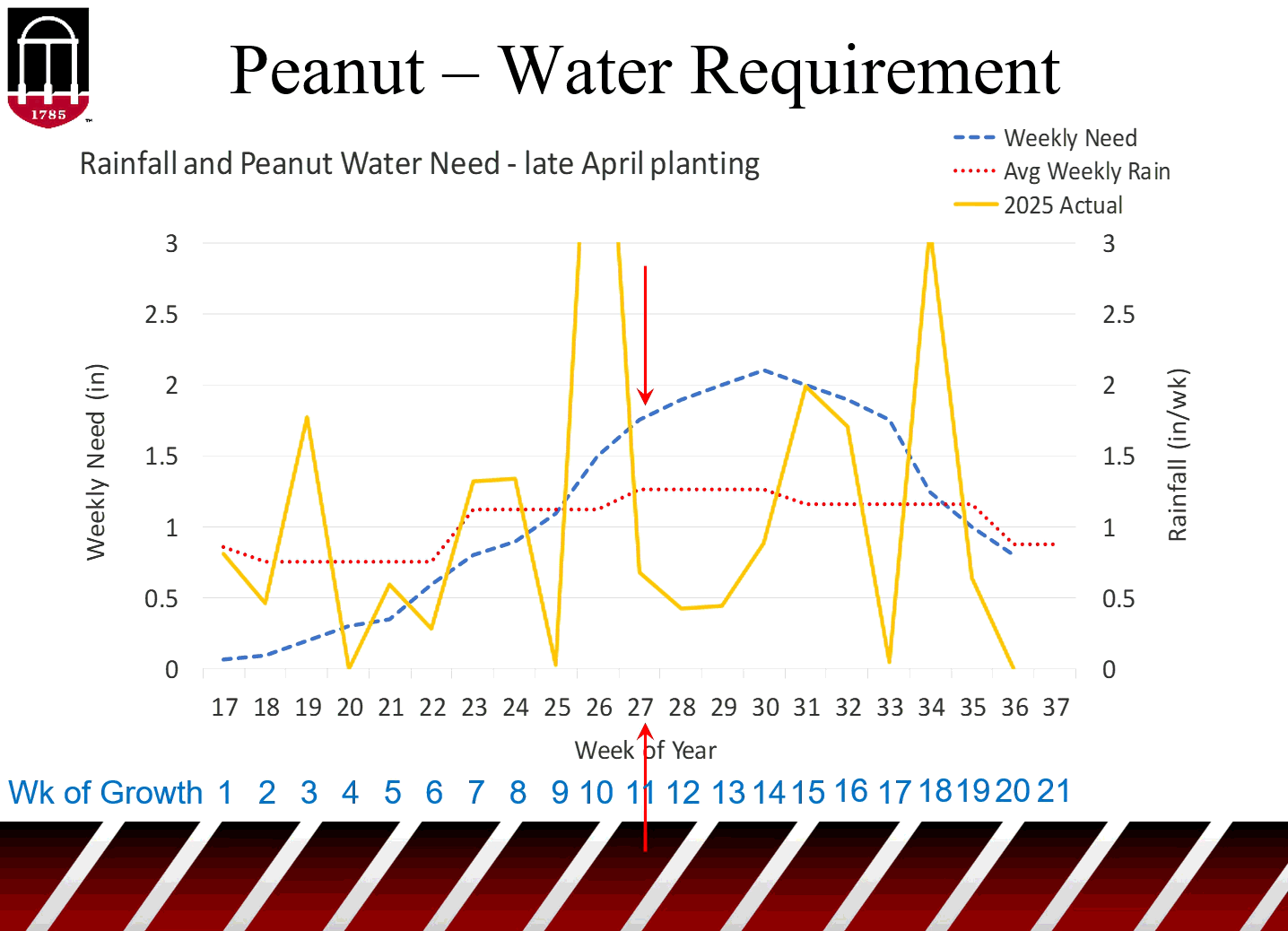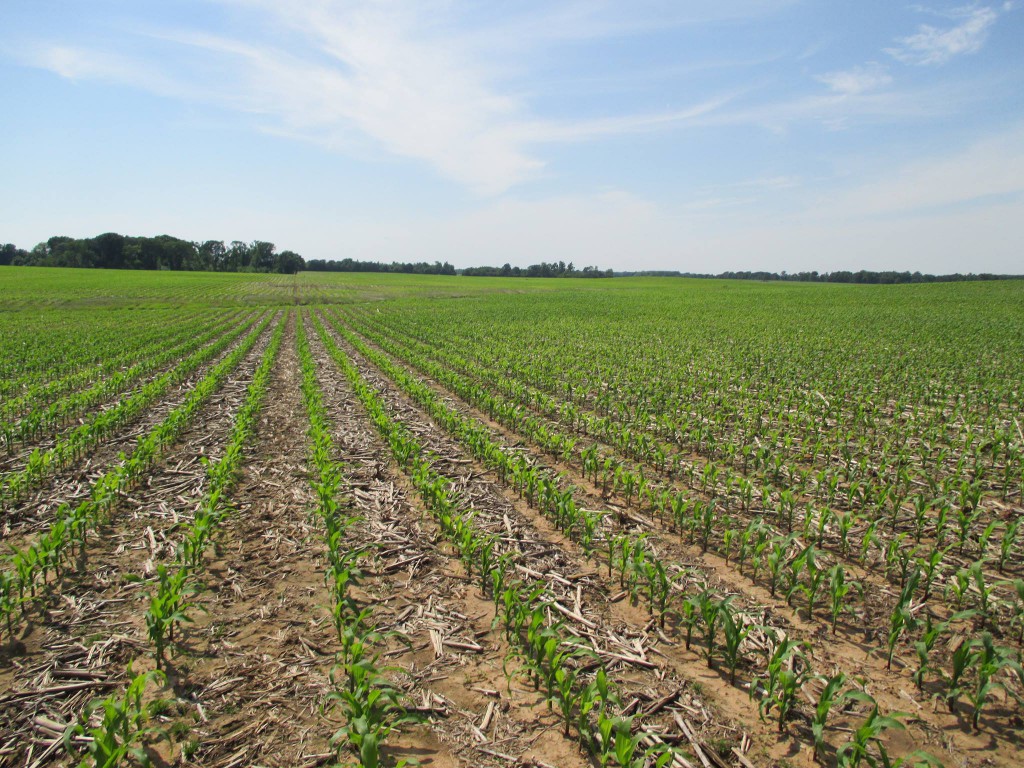By Scott Tubbs, Sarah Beth Thompson, and Wesley Porter
While we are wrapping up the peanut season, and we have seen many peanuts that have been dug and even harvested across the state, it is important to note that we are not done with the season, and peanuts will require water until they are fully mature and ready to be inverted and picked. Due to the differing dynamics of this season, depending on whether you planted late-April, mid-May, or early-June you are in three different situations from the perspective of when you received rainfall and what the crop water usage was and is. This distribution of rainfall during specific crop stages can have a significant impact on final water requirements, crop growth, and yields. The three sections below will step you through each scenario and what to expect.
Earlier Plant Date – Late April
The early planted crop has received adequate rainfall to meet the crop water demand for a large chunk of the season, minus a 3-4 week dry spell during the mid-season. Unfortunately, that dry spell occurred at a critical time as we were trying to set a large proportion of the harvestable pods. Figure 1 represents the water-use/need curve for the peanut crop (blue dashed line) and can be compared to the actual rainfall received (yellow line) to get an idea of how it may affect maturity progression. The weather turned dry from approximately weeks 11-14 of crop growth (weeks 27-30 of the year in Figure 1). This was causing anywhere from 1.0 to 1.5 inch deficits during each of those weeks, for four consecutive weeks. Since that is roughly 77-98 days after planting for peanut planted around April 23, dryland peanuts could have a split maturity profile. Therefore, you will need to take a close look at the entire maturity profile when placing these samples on the board and do not just pull the trigger based on the leading edge of the profile. As we are nearing the end of the season, digging decisions need to also include vine and peg health as they could speed up your decision to dig. For example, if there is a healthy vegetative canopy that is not crashing and defoliating from leaf spot or other pathogens, then a grower may have the luxury of leaving them in the ground longer to progress a larger percentage of the late blooms without risk of losing the oldest and most mature pods (which will be your pods with the heaviest weight). But opening the pods to look at the interior and determine whether seed have turned loose in the hull (the funiculus detached between the kernel and the pod) will also help gauge whether those peanuts can hold on for longer, or whether they will soon break dormancy and begin sprouting on the vine, hence necessitating digging early regardless of the profile recommendation.

Figure 1. Tracking an early planted (around April 23 = week 17 of the year) peanut crop, comparing water need (dashed blue line), 30-yr average weekly rainfall (dotted red line), and actual rainfall received (solid yellow line) from Tifton, GA, 2025.
Mid-May Plant Date
A mid-May planted peanut suffered through the dry spell earlier in crop’s development, where roughly weeks 9-11 were at a deficit (Figure 2 – weeks 28-30 corresponding). This means the early pod set was affected more drastically, and maturity may be delayed as later maturing peanuts continue to develop. The maturity profile may not look “split”, just shifted a few columns later than “normal” in its progression. These peanuts could possibly benefit from later digging, giving them an extra week or two to mature. If that’s the case, these may need an extra fungicide spray to carry them through to maturity. However, please be cognizant of defoliation due to leaf spot, as once greater than 50% defoliation is observed a fungicide spray will not be as effective. Also noting the dotted red line on the graph, we are entering a period of the year (week 36) where historic average rainfall becomes less in quantity, as well as fewer events that may be further between. There is a substantial deficit between the blue dashed line and the red dotted line, so irrigation is still very important to maintain the yield potential and finish filling these pods, especially if they will be pushed later. Considering we haven’t received rain in the last 15 days, and there is little chance of rain in the next 15 days of the forecast, we will enter a dry spell when these peanuts still need water to complete the yield and grade potential that is currently still very good. Going dry at this period of time just before harvest can also be a threat to aflatoxin potential, so keeping these peanuts irrigated where possible could be the difference in a Seg. 1 vs Seg. 3 load.

Figure 2. Tracking a mid-season planted (around May 14 = week 20 of the year) peanut crop, comparing water need (dashed blue line), 30-yr average weekly rainfall (dotted red line), and actual rainfall received (solid yellow line) from Tifton, GA, 2025.
Early June Plant Date
Regarding the later planted crop taking place around the first week of June, these peanuts are just now entering their peak water requirement period (Figure 3). The early dry spell during weeks 27-30 of the year did not affect these late planted peanuts much, causing only around an 0.25-inch deficit per week for only two weeks (weeks 6 and 7 of crop development; corresponding to weeks 28 and 29 of the year). Thus, as of right now, the late planted crop is progressing very nicely in terms of weekly water need. However, we are turning dry at a point where peak water need is hitting, and while entering a part of the year with historically less rainfall. With adequate rainfall on the late crop up until this point, irrigation has probably not been very necessary and may have only been turned on once or twice. If we go dry for an extended period of time over the next few weeks, like what is currently predicted, currently what is potentially a great late season crop could turn disastrous very quickly. Growers should be diligent in running irrigation on these peanuts where available to maintain and maximize yield potential. Otherwise, there could be a sharp cliff on the maturity board with a front-loaded pod set and not much on the back end. If those pods on the front edge of the maturity board start turning loose in the hull, there could be a short window to get those peanuts dug before these kernels start sprouting on the vine and a compact maturity profile could lose a large percentage of harvestable peanuts in a very short period of time.

Figure 3. Tracking a late planted (around June 4 = week 23 of the year) peanut crop, comparing water need (dashed blue line), 30-yr average weekly rainfall (dotted red line), and actual rainfall received (solid yellow line) from Tifton, GA, 2025.
Finally, remember that there is limited dryer capacity at most Buying Points. If peanuts are picked while they are still at high moisture and the dryers are all full at the Buying Point, your peanuts in the wagon are at risk to mold. It may be beneficial to leave peanuts in the field to naturally cure for an extra day or so where they are less risk to mold as quickly, and may not need to be dried, or at least spend less time on the dryer. Dryers will need to be operating efficiently moving wagons on and off quickly with such a large crop coming in during a short timeframe. At the same time, if conditions turn dry, dug vines could become dry and brittle very rapidly. Pay close attention to the condition of dug peanuts – there could be a narrower window than usual between peanuts picked too wet vs picked too dry.
